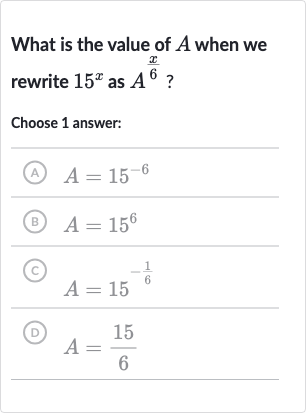Full solution
Q. What is the value of when we rewrite as ?Choose answer:(A) (B) (C) (D)
- Expressing in form: We need to express in the form of . To do this, we need to find a base such that when raised to the power of , it is equivalent to .
- Equating the exponents: Let's assume . To find , we need to equate the exponents of both sides. Since the exponent on the right side is , we need to find the sixth root of to make the bases equal.
- Finding the base : Taking the sixth root of is the same as raising to the power of . Therefore, should be equal to .
- Comparing the options: Now we compare the options given to find which one matches our result:(A) is incorrect because it represents the reciprocal of the sixth power of , not the sixth root.(B) is incorrect because it represents the sixth power of , not the sixth root.(C) is incorrect because it represents the reciprocal of the sixth root of .(D) is correct because it represents the sixth root of , which is what we need for .
More problems from Compare linear and exponential growth
QuestionGet tutor help
QuestionGet tutor help
QuestionGet tutor help
QuestionGet tutor help
QuestionGet tutor help
QuestionGet tutor help
QuestionGet tutor help

